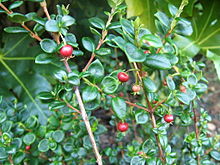| Ugni | |
|---|---|

| |
| Ugni molinae | |
| Scientific classification | |
| Kingdom: | Plantae |
| Clade: | Tracheophytes |
| Clade: | Angiosperms |
| Clade: | Eudicots |
| Clade: | Rosids |
| Order: | Myrtales |
| Family: | Myrtaceae |
| Subfamily: | Myrtoideae |
| Tribe: | Myrteae |
| Genus: | Ugni Turcz. |
| Type species | |
| Ugni molinae | |
Ugni is a genus of plants in the myrtle family Myrtaceae, described as a genus in 1848.[1][2] It is native to western Latin America from the Valdivian temperate rain forests of southern Chile (including the Juan Fernández Islands) and adjacent regions of southern Argentina, north to southern Mexico.[3]
They are shrubs with evergreen foliage, reaching 1–5 m tall. The leaves are opposite, oval, 1–4 cm long and 0.2-2.5 cm broad, entire, glossy dark green, with a spicy scent if crushed. The flowers are drooping, 1–2 cm diameter with four or five white or pale pink petals and numerous short stamens; the fruit is a small red or purple berry 1 cm diameter.[4][5][6]
- ^ Turczaninow, Nicolai Stepanowitsch. 1848. Bulletin de la Société Impériale des Naturalistes de Moscou 21(1): 579 in Latin
- ^ Tropicos, Ugni Turcz
- ^ Kew World Checklist of Selected Plant Families
- ^ Davidse, G., M. Sousa Sánchez, S. Knapp & F. Chiang Cabrera. 2009. Cucurbitaceae a Polemoniaceae. 4(1): i–xvi, 1–855. In G. Davidse, M. Sousa Sánchez, S. Knapp & F. Chiang Cabrera (eds.) Flora Mesoamericana. Universidad Nacional Autónoma de México, México.
- ^ Sánchez-Vindas, P. E. 2001. Calycolpus, Eugenia, Myrcia, Myrcianthes, Myrciaria, Pimenta, Plinia, Psidium, Syzygium, Ugni. En: Stevens, W.D., C. Ulloa, A. Pool & O.M. Montiel (eds.), Flora de Nicaragua. Monographs in systematic botany from the Missouri Botanical Garden 85(2): 1566, 1570–1574, 1575–1580
- ^ Landrum, L. R. & M. L. Kawasaki. 1997. The genera of Myrtaceae in Brazil: an illustrated synoptic treatment and identification keys. Brittonia 49(4): 508–536